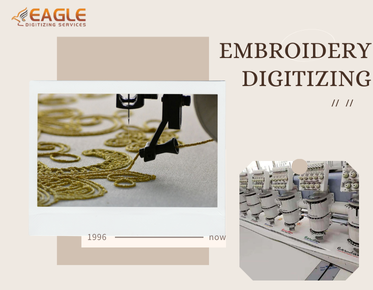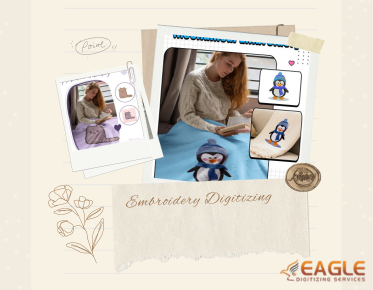Clever Techniques for Embroidery on Challenging Fabrics
Embroidery on problematic fabrics can often feel like a high-stakes puzzle. Stretchy knits, slippery silks, and fuzzy fleeces all come with their own set of challenges that can turn a straightforward project into a meticulous endeavor. But fear not—mastering these techniques can elevate your embroidery skills to new heights, turning frustrating fabrics into beautiful, embroidered creations. Embrace the challenge and discover the art of embroidering on even the most difficult materials. Here are Some Points You Should Be Aware of Regarding Embroidery Digitizing!
Understanding Problem Fabrics: What Makes Them Challenging?
Identifying Problematic Fabrics: Stretchy, Slippery, and Fuzzy
Certain fabrics present unique obstacles for embroidery. Stretchy fabrics, like jersey or spandex, can distort during the stitching process, leading to uneven designs. Slippery fabrics, such as silk or satin, tend to slide around, making precise placement difficult. Fuzzy or high-pile fabrics, including fleece and terrycloth, can cause the embroidery to sink into the pile, obscuring your design.
How Fabric Composition Affects Embroidery
The composition of a fabric—whether it’s natural like cotton or synthetic like polyester—affects how it behaves during embroidery. Natural fibers tend to absorb thread tension differently than synthetics, and different weaves or knit patterns can also impact how well the fabric holds up under the needle. Understanding these nuances can help in selecting the right approach and materials.
Common Issues: Shifting, Puckering, and Thread Breakage
Three common problems with problematic fabrics are shifting, puckering, and thread breakage. Shifting occurs when the fabric moves out of alignment during embroidery, leading to misaligned designs. Puckering results from fabric bunching up around the stitches, often due to incorrect stabilizer use. Thread breakage can happen if the fabric causes excessive friction or if the needle isn’t suitable for the fabric type.
Preparing Your Fabric for Successful Embroidery
Pre-Washing and Stabilizing: Why It Matters
Pre-washing your fabric before starting an embroidery project is crucial. It removes any finishes or sizing that can affect the fabric’s performance and allows you to see how the fabric will react to washing and wearing. Stabilizing is equally important, as it provides support and structure to the fabric during the embroidery process, preventing distortion and ensuring clean results.
Choosing the Right Stabilizer for Different Fabrics
The type of stabilizer you choose—tear-away, cut-away, or wash-away—depends on the fabric and design. Tear-away stabilizers are great for light to medium fabrics, while cut-away stabilizers offer more support for heavier or stretchy materials. Wash-away stabilizers are ideal for delicate fabrics where you don’t want any residue left behind. Selecting the right stabilizer is key to achieving a professional finish.
How to Cut and Prepare Fabrics for Embroidery
Proper cutting and preparation of your fabric ensure accuracy and reduce issues during embroidery. Cut your fabric slightly larger than needed to accommodate any shifting or puckering. Press the fabric to remove wrinkles and ensure a smooth surface. If working with stretchy fabrics, consider using fusible interfacing to add stability before embroidery.
Dealing with Stretchy Fabrics: Tips and Tricks
Using Tear-Away vs. Cut-Away Stabilizers for Stretchy Fabrics
For stretchy fabrics, cut-away stabilizers provide the necessary support to maintain the shape of the design and prevent stretching. Tear-away stabilizers can work if the fabric is not overly stretchy, but they may require careful handling to avoid pulling the fabric out of shape. Choose the stabilizer based on the fabric’s stretchiness and the complexity of your design.
Techniques for Avoiding Puckering on Knit Materials
To prevent puckering on knit fabrics, use a stabilizer that provides adequate support without adding bulk. Adjust the tension on your embroidery machine to avoid excessive strain on the fabric. Additionally, consider using a ballpoint needle designed for knits to smoothly navigate through the fibers without causing snags.
Tips for Stabilizing and Hooping Stretchy Fabrics
When hooping stretchy fabrics, ensure that the fabric is taut but not stretched out. Use a hooping method that minimizes fabric distortion, such as the “floating” technique where the fabric is placed on top of the stabilizer rather than inside the hoop. This approach helps maintain fabric integrity and reduces the risk of shifting.
Embroidery on Slippery Fabrics: How to Keep Things in Place
Using Sticky Stabilizers and Adhesive Sprays
For slippery fabrics like silk or satin, sticky stabilizers and adhesive sprays can be invaluable. Apply a sticky stabilizer to the back of the fabric to keep it in place during embroidery. Alternatively, use an adhesive spray to temporarily bond the fabric to the stabilizer, preventing it from shifting out of alignment.
Tips for Hooping and Stabilizing Slippery Materials
When working with slippery materials, hoop the fabric with extra care to avoid shifting. Use a hoop with a grippy surface or a stabilizer with a strong adhesive to hold the fabric securely. Be gentle when handling the fabric to avoid stretching or distorting it during the process.
Avoiding Common Pitfalls When Working with Silks and Satins
Silks and satins are prone to slipping and can easily be marred by needle marks. Use a fine needle and a stabilizer that provides adequate grip. Ensure that the hoop is not too tight, which can cause puckering, and always test on a scrap piece of fabric to perfect your technique.
Tackling Fuzzy and High-Pile Fabrics: Making Your Design Pop
Choosing the Right Needle and Thread for High-Pile Fabrics
When embroidering on high-pile fabrics, such as fleece or terrycloth, choose a needle with a larger eye and a ballpoint tip to navigate through the pile without getting stuck. Use thick, sturdy thread that can stand up to the fabric’s texture and prevent getting lost in the fuzz.
Using Water-Soluble Stabilizers to Manage Fuzziness
Water-soluble stabilizers are particularly effective for fuzzy fabrics. They dissolve after embroidery, leaving no residue behind and preventing the design from sinking into the pile. Place the stabilizer on top of the fabric if necessary, to keep the stitches visible and clean.
How to Ensure Your Design Stands Out on Plush Fabrics
To make your design stand out on plush fabrics, use a high-contrast thread color and increase the stitch density. Consider using techniques like 3D embroidery or adding extra layers of thread to enhance the design’s visibility and texture.
Embroidery Techniques for Delicate Fabrics
Adjusting Tension Settings for Lightweight Fabrics
Lightweight fabrics require delicate handling. Adjust the tension settings on your embroidery machine to a lower setting to avoid puckering and snags. Test on a scrap piece of fabric to ensure the tension is appropriate for the delicate material.
How to Use a Low-Tension Thread to Prevent Snagging
Using a low-tension thread helps prevent snagging and pulling on delicate fabrics. Opt for threads specifically designed for lightweight materials, which have a smoother texture and are less likely to catch or break during the embroidery process.
Tips for Handling Fabrics Like Organza and Chiffon
When working with fabrics like organza and chiffon, which are prone to fraying and shifting, use a stabilizer to provide support. Hoop the fabric with care to avoid distortion and consider using a needle with a fine point to handle the delicate threads without causing damage.
Choosing the Right Needle and Thread for Each Fabric Type
Understanding Needle Sizes and Types: Ballpoint vs. Sharp
Needle size and type play a crucial role in the success of your embroidery. Ballpoint needles are ideal for knits and stretchy fabrics as they push the fibers aside rather than piercing them. Sharp needles are best for woven fabrics and those requiring precision.
Selecting the Best Thread Type for Different Fabrics
Choose thread types based on the fabric and desired finish. For example, polyester threads are strong and versatile for most fabrics, while rayon threads offer a glossy finish for more decorative pieces. Ensure that the thread matches the fabric’s texture and weight.
How to Match Your Needle and Thread to Fabric Characteristics
To achieve the best results, match your needle and thread to the fabric’s characteristics. For heavy fabrics, use a larger needle and thicker thread. For delicate fabrics, choose a finer needle and thread to avoid damage and ensure a smooth finish.
Special Stabilizing Techniques for Problem Fabrics
Using Dual-Layer Stabilizers for Extra Support
For fabrics that require additional support, consider using dual-layer stabilizers. Combine a tear-away or cut-away stabilizer with a water-soluble top layer to provide extra stability and prevent shifting. This technique helps in managing complex or detailed designs.
Temporary vs. Permanent Stabilizers: What’s the Difference?
Temporary stabilizers are used for support during embroidery and are removed afterward, such as sticky stabilizers. Permanent stabilizers remain in place after stitching, providing long-term support, especially for designs on soft or stretchy fabrics. Understanding when to use each type is crucial for achieving the desired result.
Techniques for Properly Applying and Removing Stabilizers
Apply stabilizers evenly and securely to ensure consistent support. Use adhesive sprays or temporary stitches to attach stabilizers if needed. After embroidery, carefully remove the stabilizer, following the manufacturer’s instructions to avoid damaging the fabric or design.
Managing Fabric Movement During Embroidery
Using Hoop Techniques to Minimize Fabric Shifting
To minimize fabric shifting, use a hooping technique that ensures the fabric remains stable. Choose a hoop with a grippy surface or use temporary adhesive to secure the fabric. Proper hoop tension is also key—too tight can distort the fabric, while too loose can lead to shifting.
How to Secure Fabric in Place with Basting Stitches
Basting stitches are a great way to secure the fabric in place before starting the embroidery. Use a loose, temporary stitch around the edges of the fabric to hold it steady and prevent movement. This technique is especially useful for fabrics prone to shifting.
Strategies for Avoiding Thread Breakage and Tension Issues
Thread breakage and tension issues can be minimized by regularly checking and adjusting your machine settings. Ensure that the thread path is clear of obstructions, and use the correct needle and thread for the fabric type. Regularly clean and maintain your machine to keep it in optimal condition.
Dealing with Fabric Shrinkage Post-Embroidery
How to Pre-Shrink Fabrics Before Embroidery
Pre-shrinking fabrics before embroidery helps prevent unexpected shrinkage after the design is complete. Wash and dry the fabric according to its care instructions to preemptively address any shrinkage issues.
Techniques for Managing Shrinkage After the Fact
If shrinkage occurs after embroidery, you can carefully block the fabric to restore its shape. Use an iron on a low setting and press the fabric gently to avoid distorting the embroidery. Adjust the design size if necessary to accommodate the new dimensions.
Tips for Adjusting Designs for Fabric Shrinkage
When working with fabrics prone to shrinkage, consider increasing the design size slightly to account for potential reduction. Test your design on a sample piece of fabric to estimate how much it may shrink and adjust accordingly.
Navigating the world of embroidery on difficult fabrics requires patience, experimentation, and a willingness to adapt. By employing specialized techniques and tools, you can turn even the most challenging materials into beautiful embroidered works of art. Embrace the complexity, apply these strategies, and watch your embroidery skills flourish, no matter the fabric.



